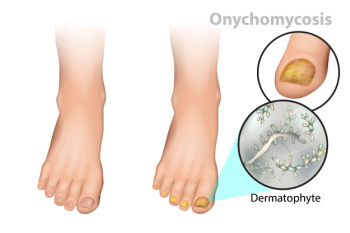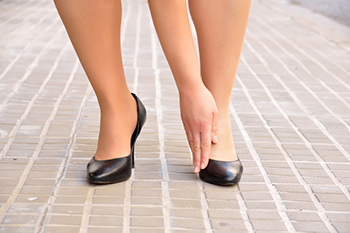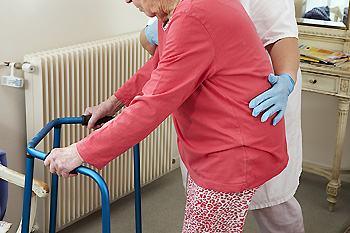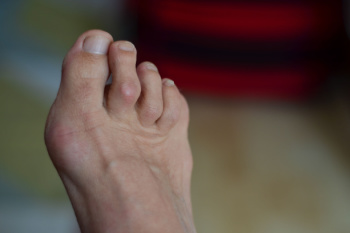Items filtered by date: July 2025
Treatment Choices for Toenail Fungus

Toenail fungus, also called onychomycosis, often requires professional treatment to fully resolve. Your podiatrist may suggest oral medications, topical treatments, or laser therapy, depending on the severity of the infection. Oral antifungal pills tend to be the most effective but can cause side effects like an upset stomach or liver concerns. Topical solutions avoid these risks but often take longer to show results and may not work for deep infections. Laser treatments offer a non-invasive option, although results can vary. Your podiatrist will consider your health history and the extent of the infection when recommending a treatment plan. Treatment success also depends on how carefully you follow instructions, as missing medication doses or stopping early can lead to failure. If you have developed toenail fungus, it is suggested you visit a podiatrist to discuss safe and effective treatment options.
If left untreated, toenail fungus may spread to other toenails, skin, or even fingernails. If you suspect you have toenail fungus it is important to seek treatment right away. For more information about treatment, contact Sharmila Das-Wattley, DPM of Home Wound Healing. Our doctor can provide the care you need to keep you pain-free and on your feet.
Symptoms
- Warped or oddly shaped nails
- Yellowish nails
- Loose/separated nail
- Buildup of bits and pieces of nail fragments under the nail
- Brittle, broken, thickened nail
Treatment
If self-care strategies and over-the-counter medications does not help your fungus, your podiatrist may give you a prescription drug instead. Even if you find relief from your toenail fungus symptoms, you may experience a repeat infection in the future.
Prevention
In order to prevent getting toenail fungus in the future, you should always make sure to wash your feet with soap and water. After washing, it is important to dry your feet thoroughly especially in between the toes. When trimming your toenails, be sure to trim straight across instead of in a rounded shape. It is crucial not to cover up discolored nails with nail polish because that will prevent your nail from being able to “breathe”.
In some cases, surgical procedure may be needed to remove the toenail fungus. Consult with your podiatrist about the best treatment options for your case of toenail fungus.
If you have any questions please contact our office located in Florida . We offer the newest diagnostic and treatment technologies for all your foot and ankle needs.
Beauty Meets Foot Health

Many women love high heels for the way they enhance posture, style, and confidence. However, frequent wear can take a serious toll on foot health. High heels shift weight forward, placing excessive pressure on the toes and the balls of the feet. This can lead to bunions, hammertoes, nerve pain, and even long-term joint damage. Wearing heels regularly may also affect balance and cause strain in the ankles and lower back. A podiatrist can identify early signs of damage, provide relief, and suggest supportive alternatives or custom inserts. If you enjoy wearing high heels but notice foot pain or discomfort, it is suggested that you consult a podiatrist who can treat various foot conditions, and guide you on types of heels that might be easier on your feet.
High heels have a history of causing foot and ankle problems. If you have any concerns about your feet or ankles, contact Sharmila Das-Wattley, DPM from Home Wound Healing. Our doctor can provide the care you need to keep you pain-free and on your feet.
Effects of High Heels on the Feet
High heels are popular shoes among women because of their many styles and societal appeal. Despite this, high heels can still cause many health problems if worn too frequently.
Which Parts of My Body Will Be Affected by High Heels?
- Ankle Joints
- Achilles Tendon – May shorten and stiffen with prolonged wear
- Balls of the Feet
- Knees – Heels cause the knees to bend constantly, creating stress on them
- Back – They decrease the spine’s ability to absorb shock, which may lead to back pain. The vertebrae of the lower back may compress.
What Kinds of Foot Problems Can Develop from Wearing High Heels?
- Corns
- Calluses
- Hammertoe
- Bunions
- Morton’s Neuroma
- Plantar Fasciitis
How Can I Still Wear High Heels and Maintain Foot Health?
If you want to wear high heeled shoes, make sure that you are not wearing them every day, as this will help prevent long term physical problems. Try wearing thicker heels as opposed to stilettos to distribute weight more evenly across the feet. Always make sure you are wearing the proper shoes for the right occasion, such as sneakers for exercising. If you walk to work, try carrying your heels with you and changing into them once you arrive at work. Adding inserts to your heels can help cushion your feet and absorb shock. Full foot inserts or metatarsal pads are available.
If you have any questions, please feel free to contact our office located in Florida . We offer the newest diagnostic and treatment technologies for all your foot care needs.
Heel Pain Caused by Running

Heel pain from running often results from repeated stress on the foot. One frequent cause is plantar fasciitis, which involves strain on the band of tissue that runs along the bottom of the foot and connects to the heel. Other causes of heel pain include Achilles tendonitis, heel stress fractures, or joint and nerve irritation. People with flat feet or high arches may be more prone to heel pain, especially if they wear shoes without proper support. Running on hard surfaces, increasing mileage too quickly, or having poor foot alignment can also add pressure to the heel. A podiatrist can examine the foot and determine the exact source of pain. Based on the diagnosis, this type of doctor may recommend a gait analysis, custom orthotics, shoe modifications, or surgery, in severe cases. Early attention to heel pain can help prevent long-term damage. If you experience heel pain from running, it is suggested that you schedule an appointment with a podiatrist for an exam and appropriate treatment options.
Many people suffer from bouts of heel pain. For more information, contact Sharmila Das-Wattley, DPM of Home Wound Healing. Our doctor can provide the care you need to keep you pain-free and on your feet.
Causes of Heel Pain
Heel pain is often associated with plantar fasciitis. The plantar fascia is a band of tissues that extends along the bottom of the foot. A rip or tear in this ligament can cause inflammation of the tissue.
Achilles tendonitis is another cause of heel pain. Inflammation of the Achilles tendon will cause pain from fractures and muscle tearing. Lack of flexibility is also another symptom.
Heel spurs are another cause of pain. When the tissues of the plantar fascia undergo a great deal of stress, it can lead to ligament separation from the heel bone, causing heel spurs.
Why Might Heel Pain Occur?
- Wearing ill-fitting shoes
- Wearing non-supportive shoes
- Weight change
- Excessive running
Treatments
Heel pain should be treated as soon as possible for immediate results. Keeping your feet in a stress-free environment will help. If you suffer from Achilles tendonitis or plantar fasciitis, applying ice will reduce the swelling. Stretching before an exercise like running will help the muscles. Using all these tips will help make heel pain a condition of the past.
If you have any questions, please feel free to contact our office located in Florida . We offer the newest diagnostic and treatment technologies for all your foot care needs.
Are You Suffering From Nerve Damage?
Fall Prevention Tips for Seniors

Falling is a major concern for seniors and can result from various factors, including medication side effects, poor vision, reduced physical fitness, unsafe home environments, and improper footwear. Wearing supportive, well-fitting shoes and maintaining a clutter-free home can reduce risk. Falls may lead to serious foot injuries, such as sprains, fractures, or dislocations. A podiatrist can assess foot health, recommend proper footwear, and provide guidance on ways to improve balance and mobility. They can also address any underlying foot conditions that may contribute to instability. If you or a loved one has sustained a foot injury from falling, it is suggested that you promptly contact a podiatrist who can treat various foot conditions and guide you toward effective fall prevention techniques.
Preventing falls among the elderly is very important. If you are older and have fallen or fear that you are prone to falling, consult with Sharmila Das-Wattley, DPM from Home Wound Healing. Our doctor will assess your condition and provide you with quality advice and care.
Every 11 seconds, an elderly American is being treated in an emergency room for a fall related injury. Falls are the leading cause of head and hip injuries for those 65 and older. Due to decreases in strength, balance, senses, and lack of awareness, elderly persons are very susceptible to falling. Thankfully, there are a number of things older persons can do to prevent falls.
How to Prevent Falls
Some effective methods that older persons can do to prevent falls include:
- Enrolling in strength and balance exercise program to increase balance and strength
- Periodically having your sight and hearing checked
- Discuss any medications you have with a doctor to see if it increases the risk of falling
- Clearing the house of falling hazards and installing devices like grab bars and railings
- Utilizing a walker or cane
- Wearing shoes that provide good support and cushioning
- Talking to family members about falling and increasing awareness
Falling can be a traumatic and embarrassing experience for elderly persons; this can make them less willing to leave the house, and less willing to talk to someone about their fears of falling. Doing such things, however, will increase the likelihood of tripping or losing one’s balance. Knowing the causes of falling and how to prevent them is the best way to mitigate the risk of serious injury.
If you have any questions, please feel free to contact our office located in Florida . We offer the newest diagnostic and treatment technologies for all your foot care needs.
Surgery Options for Hammertoe Deformity

Hammertoe surgery is a procedure to correct a deformity in the second, third, or fourth toe when the middle joint bends and the toe looks like a hammer. This outpatient procedure is designed to lessen pain and improve flexibility when the toe muscles cannot stretch and straighten on their own. A podiatrist may recommend hammertoe surgery after conservative options have failed. Options include fusion, tendon transfer, or joint resection to straighten the toe. Fusion cuts the bone ends and uses pins, rods, or screws to keep the toe straight. Tendon transfer reroutes a tendon to help the toe lie flat. Joint resection removes part of the bone and uses pins to hold alignment. Recovery from hammertoe surgery involves wearing a surgical shoe or boot, keeping weight off the foot, and follow-up visits for pin or stitch removal. If you have a painful hammertoe, it is suggested that you schedule an appointment with a podiatrist for an exam and appropriate treatment options.
Foot surgery is sometimes necessary to treat a foot ailment. To learn more, contact Sharmila Das-Wattley, DPM of Home Wound Healing. Our doctor will assist you with all of your foot and ankle needs.
When Is Surgery Necessary?
Foot and ankle surgery is generally reserved for cases in which less invasive, conservative procedures have failed to alleviate the problem. Some of the cases in which surgery may be necessary include:
- Removing foot deformities like bunions and bone spurs
- Severe arthritis that has caused bone issues
- Cosmetic reconstruction
What Types of Surgery Are There?
The type of surgery you receive will depend on the nature of the problem you have. Some of the possible surgeries include:
- Bunionectomy for painful bunions
- Surgical fusion for realignment of bones
- Neuropathy decompression surgery to treat nerve damage
Benefits of Surgery
Although surgery is usually a last resort, it can provide more complete pain relief compared to non-surgical methods and may allow you to finally resume full activity.
Surgical techniques have also become increasingly sophisticated. Techniques like endoscopic surgery allow for smaller incisions and faster recovery times.
If you have any questions, please feel free to contact our office located in Florida . We offer the newest diagnostic and treatment technologies for all your foot care needs.

